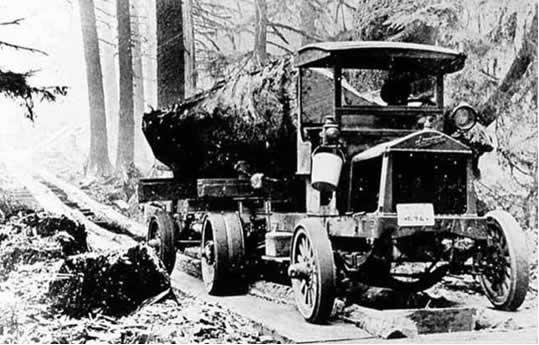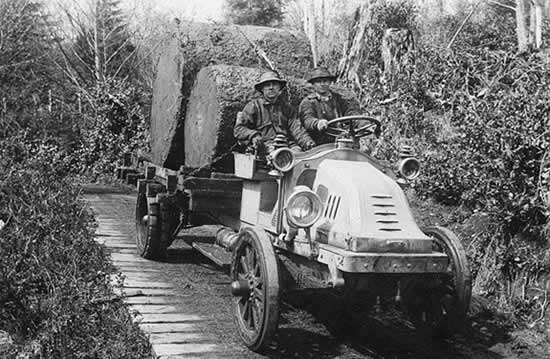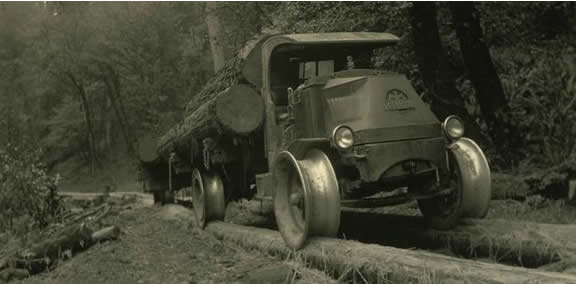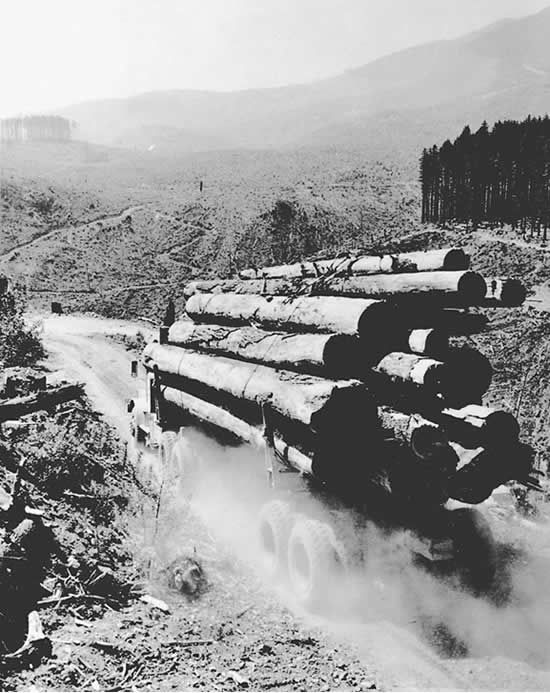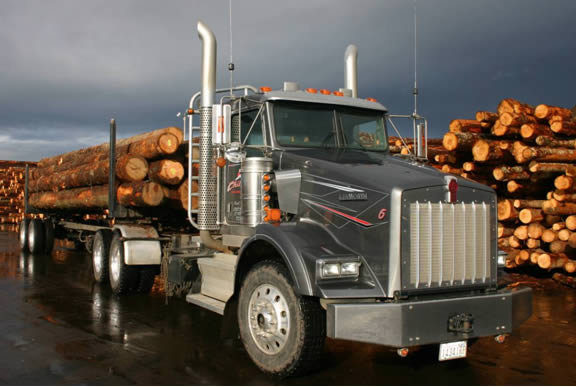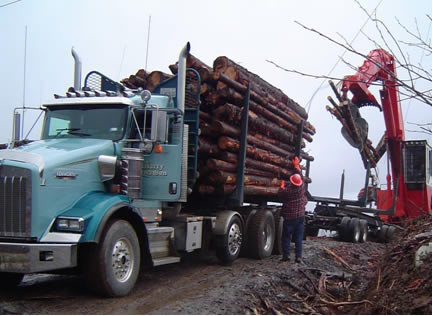 |
 |
 |
 |


The Washington Log Trucking Industry:
Costs and Safety Analysis
Section I: BackgroundThe Washington forest industry employs 45,000 people and annually generates $2 billion in wages, $16 billion in gross business revenues and over $100 million in tax receipts (Eastin et al. 2007). Washington produces six billion board feet of lumber per year, one billion square feet of plywood panels (3/8” basis), and seven million tons of pulp and paper products (Eastin et al. 2007, Ince et al. 2001). A comparison of production statistics by state indicates that Washington has the second largest lumber production in the nation and is fourth in production of both plywood and pulp and paper products (Eastin et al. 2007, Ince et al. 2001). All of this activity is dependent upon truck transport to move raw logs from the woods to process facilities. HistoryIn 1915, the Gerlinger Motor Car Company of Seattle produced its first truck; framed in heavy steel and powered by a six-cylinder engine. Eight years later this company would become known as Kenworth (Kenworth Truck Company). With the coming of World War I, movements of troops, supplies, and food overloaded the nation’s rail system. Equipment manufacturers responded with production of gasoline-powered trucks to ease domestic transportation demands, as well as to provide machinery needed abroad by the military (Peterbilt Motor Company). The first known use of a truck in a logging operation in Washington occurred in 1913 near Covington (Knapp 1921) but it was World War I (WWI) that established log trucking in Washington. In 1917, fine quality Sitka spruce, unique to the forests of the Pacific Northwest, was urgently needed to manufacture airplanes for the war. However, the best spruce trees were dispersed here and there requiring selective harvest that was impractical for railroad logging. The army organized the Spruce Production Division, which assigned thousands of soldiers to build roads into the forests of western Washington. Hard-tired trucks were put to use to travel on plank roads and retrieve the cants of spruce that were felled, bucked and split by woods crews (Prouty 1982).
Following the Armistice in November 1918, the Spruce Production Division was disbanded but newly constructed roads, surplus trucks, and accessible timber stands remained and provided the beginning for what would become the rapid growth in the use of trucks for commercial log hauling. New interest in the use of aircraft combined with the ready availability of a spruce resource helped to establish the new Boeing Corporation as a mainstay of the economy of Washington and a purchaser of spruce logs for many years (Williams 1999). After WWI, an expanding economy brought a steady increase in road construction and motor vehicle use. Small log producers were quick to recognize opportunity. The purchase and operation of trucks was much less costly than locomotives. Isolated patches of timber near new public roads could be purchased and hauled by truck at low cost. Salvage of shingle cedar and Douglas-fir peeler blocks became possible. Track-type tractors had been developed for use in WWI. This equipment soon too found popular logging application. The logging industry, long dominated by big companies with logging camps and railroad lines, began to change. With the tractor and the truck came the independent or “gyppo” logger and the contract “gyppo” trucker. These were small businesses many of which would become primary log suppliers for small sawmills (Brown 1936).
Motor trucks were found to be uniquely versatile. When trucks weren’t hauling logs they could be used for delivering equipment and supplies. Larger logging companies with big contiguous timber holdings that employed railroads to move huge volumes of timber also found trucks useful for operation on spur roads to bring scattered log volumes to train reloads (Knapp 1921). There were several types of roads used in the early days of truck logging. In dry weather a cleared dirt path might suffice. But for year-round travel a more substantial road was needed. Three types of roads were most favored and all were made of wood (See Appendix C). A “cross-plank” road (Figure 1.2) was made of sawn timbers spiked to hewn log stringers. A “fore and aft” pole road was constructed of hemlock poles that were available in the woods. Trucks operating on pole roads were fitted with steel flange wheels (Figure 1.3). For greater permanence in applications where a large volume of logs was to be hauled, a “fore and aft” plank road could also be constructed (Figure 1.1). All used considerable amounts of wood with the fore and aft plank requiring the most; about 160,000 board feet per mile (Knapp 1921). In the early 1920s on good roads with favorable grades, logging trucks traveled at rate of speed of 10 to 12 miles per hour. The maximum haul distance was generally limited to 15 miles (Bryant 1923). A new log truck could be purchased for about $4000 and was expected to last four years (Knapp 1921).
In 1919, C.L. Cummins introduced the diesel engine for use in commercial trucks (Peterbilt). Diesel fuel was a third the cost of gasoline (Kenworth). By the 1920s and 1930s, progress came quickly for the gyppo loggers. Improvements in truck motors and design increased the popularity of trucks in logging operations. More engine horsepower allowed for transport of larger payloads at greater speed. Better brakes made trucks safer. The introduction of wider pneumatic tires with treads allowed for greater truck speed, rougher road conditions, and greater carrying capacities. !n, 1925, The Holt Manufacturing Company and the C.L. Best Tractor Company merged to form the Caterpillar Tractor Company. Track-type tractors became known as “Cats” (Caterpillar Inc.). Road graders were introduced. Logging companies were able to easily construct graded gravel roads, substituting for the labor- and material-intensive wood style of forest road. The log truck trailer was developed with an adjustable wooden reach that allowed trucks to haul more weight with greater flexibility for log length variation (Knapp 1921). Trucks could be equipped with winches with which to pull trees to the road (“yarding”) and load the logs onto a trailer (Brown 1936). By this time it was clear that log trucking was established as a permanent fixture in the logging industry, one that would eventually replace railroads and become the sole source of transport. By 1931, there were about 900 trucks operating in Oregon and Washington (Van Tassel and Bluestone 1940). By the mid-1930s, trucks were hauling about as many trees out of Pacific Northwest forests as were railroads (Oregon History Project). The operational flexibilities of log trucks made possible development of silviculture practices such as commercial thinning, salvage of distressed timber, and staggered harvest sites or “settings”. In addition to low cost log hauling, trucks were shown to be valuable for fire fighting, machinery movement, crew transport, quick repairs to woods machinery, crew safety (rapid evacuation of injured personnel), fire safety (no sparks as were common with railroads), reduced yarding distances, year-round operation of logging sides and small mills, and operation on steeper terrain (Murray 1948). Brown (1936) wrote a text on logging transportation, concluded that trucks were here to stay, and provided early analysis of the cost of operations for logging trucks. He recognized the entrepreneurial benefits of trucks for low cost to entry into the logging business but offered a precautionary note. Based upon his observations of the uniquely independent and small-operator-dominated contract hauling industry, he expressed concern that many truckers did not did not know how to accurately determine the cost of operations including depreciation, taxes, interest charges, fuel, oil, repairs, and etc. Brown suggested, as a consequence, that some contract log truckers were hauling logs at rates below cost of operations thereby creating instability within the timber industry.
Truck and trailer equipment and operationToday, in the Pacific Northwest, truck tractors are configured for log hauling with a single set of bunks and stakes attached to a turn table mounted on the frame. The standard log haul tractor is a tandem-axle truck. The “headache rack,” located directly behind the cab, is a heavy bulkhead made of pipe and meant to stop any forward cargo shift. The tractor pulls a trailing set of log bunks and stakes also mounted on a turn table under which there are two non-powered axles. Bunks cradle loaded logs and, when used for hauling on public roads, are limited in Washington to eight foot six inches in width to the outside of the stakes. The maximum height of the loaded truck must not exceed 14 feet. To receive a load of logs, the trailer is attached to the tractor with a length-adjustable steel tube called a “reach” or “stinger”. The reach is adjustable to accommodate loads of different lengths. Under this arrangement the tractor shares the weight of the log load with the trailer. Log truck bunks are designed to swivel up to 360 degrees. When the log truck is not loaded, pins are inserted in the turn tables to keep bunks stationary. When the log truck is ready to receive a load, the pins are removed so that the load will turn and the trailer will track properly. All loads must, by law, be secured with chains and cables known as “wrappers or binders.” For binder location specifications see Appendix D. Both tractor and trailer are equipped with air brakes. The Jacobs “jake” brake is an engine retarder that increases braking efficiency by manipulating the engine valves to use engine compression to slow the vehicle.
An additional trailer with twin bunks and stakes, referred to as a “pup,” can be trailed to haul a second load. Pup trailers are free rolling on two independent axles. Tractors and trailers can be equipped with “drop axles,” air-powered lift-axles which, when lowered, provide greater load carrying capacity. When short logs are to be hauled, a “mule train” or “hay rack” is preferred. Mule train tractor frames are extended to accommodate a second set of bunks and stakes such that a log load is entirely supported by the truck. A trailer is pulled behind to haul a second load. A hay rack is a flatbed fixed with multiple sides or stakes to safely retain a load of many piece lengths. All log trucks other than hayracks approach the loading location or “landing” empty with the trailer loaded “piggyback.” Piggyback refers to the way empty log trailers are carried on the bed of a tractor such that no axles touch the ground, tire wear is reduced, and maneuverability is maximized (see Figure 2.1). When an empty trailer is carried on the tractor, the tractor stakes are positioned between the trailer wheels and the reach rests in a notched receptacle located on the top of the headache rack. Pup trailers are towed loaded or empty except in the case of the mule train. Use of hay racks on logging roads can be problematic due to the extended length of the trailer. For images of the variety of log truck configurations currently in use see Appendix A. For all log trucks, knowing the loaded weight is important for operating safely, maximizing payloads, and avoiding overweight fines. On-board scales use either load cell technology or pressure readings from air suspension to calculate the weight on the vehicle axles. Correctly operating on-board weight scales are very cost-effective tools. Payloads can be confidently maximized at the landing eliminating concern for violation of legal load limits (Conway 1976). In the early 1970’s, as truck-mounted scales first achieved broad use and truckers could confidently load up to legal weight limits, average increases in load size approached ten percent (Arola 1972). Travel time and haul costs are affected by road surface, gradient, road alignment, haul distance, and other road-related factors such as width and turnout locations. The cost of hauling logs varies with the length of the haul. The longer the distance the higher the per-unit cost. Very short hauls require more time for being loaded, unloaded, scaled, and weighed. In addition, short hauls generally mean disproportionate time spent on woods roads, with steeper grades, more curves, and narrower widths than on public roads. Unlike other commercial freight carriers, about one half of a log truck’s daily miles are driven empty during return to the woods. Regulation of truck ratesThe Motor Carrier Act of 1935 gave the Interstate Commerce Commission (ICC), a federal government agency, the authority to regulate interstate truck and bus companies, known collectively as "motor carriers." The ICC's new powers with respect to motor carriers were similar to those it had over railroads, which it had regulated since 1887. The ICC imposed regulatory limits to entry into the trucking business by determining which companies could become motor carriers, what services they could offer, and what rates they could charge. The constitutionality of the act rested on Congressional authority to regulate interstate commerce under Article I, section 8 of the U.S. Constitution. The Federal interstate regulatory system operated under the direction of the ICC with little public notice or debate from 1935 to the 1960s. President John F. Kennedy, in the early 1960’s, urged greater reliance on the forces of competition and less reliance on the restraints of regulation. In 1971, President Richard Nixon's Council of Economic Advisers called for deregulation of the transportation industries. Presidents Gerald Ford and Jimmy Carter both supported a relaxation of regulation. In 1980, at Carter’s behest, Congress passed the Motor Carrier Regulatory Reform and Modernization Act (MCA) of 1980 which significantly reduced the level of ICC regulation over the trucking industry, though it did not eliminate interstate regulation entirely. Congress finally ended sixty years of motor carrier regulation with the ICC Termination Act of 1995. This act eliminated virtually all economic control of motor carriers and abolished the ICC. Many investigations have been conducted over the years to investigate the costs and benefits of trucking deregulation. Some report positive while others report negative outcomes (Belman and Monaco 2001, Peoples and Peteraf 1999, Brown and Greenlee 1995, Allen et al. 1993, McMullen and Stanley 1988, Glaskowsky 1986, Corsi etal. 1981, Moore 1978). As the ICC regulated interstate commercial motor carrier activities, the Washington Utilities and Transportation Commission (WSUTC) regulated the within state (intrastate)trucking industry. The WSUTC limited entry by requiring trucking companies desiring to haul commercial loads to prove fitness, need, and necessity. The WSUTC also determined the rates that trucking companies, including log haulers, were paid by shipping clients for intrastate deliveries. “State rates” explicitly defined the formulas for the calculation of transport charges. Five distinct road quality types were identified to which different cost/revenue factors were assigned. Billing for hauling services was determined upon measurement of road segment types, multiplied by the road type rate, with all segment charges then summed to establish the total cost for any given log haul route. Explicit prescriptions were also provided for calculation of ancillary charges such as loading, unloading, and wait time. A completed classification of each haul contract was required to be filed with a WSUTC no later than five days after commencing transportation. Regulatory periodic adjustments to road rates were imposed through the years to keep pace with a changing economy. Passage of the federal Motor Carrier Act in 1980 did not conflict with state regulation of intrastate commercial trucking rates. In 1994, however, the United States Congress passed the Federal Aviation Administration Act of 1994 which found that the regulation of intrastate transportation of property by individual states had imposed an unreasonable burden on interstate commerce by impeding the free flow of trade, traffic, and transportation. The WSUTC responded with an emergency rule that repealed and amended portions of the Washington Administrative Code (WAC) and the Revised Code of Washington (RCW) that regulated haul rates. The intrastate commercial carrier industry in Washington, including log hauling, was “deregulated” by the passage of the Federal Aviation Administration Act. Since 1995, when the law went into effect, the state no longer has had jurisdictional authority to regulate entry or rates for commercial log hauling. Weight limits, hours of service, and other aspects of safe operation of commercial trucks are still subject to state authority. Currently there is debate over whether national uniform standards for all trucking activities should be established by the federal government. The displacement of railroads by trucks as the main source of log transport was an historic event that resulted in a unique evolution of machinery, business, culture, and regulation. For the majority of the seven decades since Brown (1936) first warned of gyppo contractors hauling logs below actual costs, regulations served to impose rate stability on the log trucking industry. In recent years, however, deregulation of haul rates combined with rapid increases in operating costs have created new questions about the safety and sustainability of a log trucking industry struggling to adapt to changing circumstances. Study MethodsIn 2007, the State Legislature requested that scientists from the University of Washington and Washington State University undertake an investigation of the Washington log truck industry towards gaining better understanding of “the costs to safely provide log hauling services.” Deregulation of the trucking industry, rising fuel prices, declining wood markets, shortages of skilled drivers, increases in traffic congestion and other ensuing circumstances have added new operational pressures for the log truck industry that could logically have safety implications. Investigation methods were designed to gather pertinent information from multiple sources:
|

